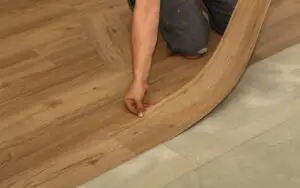Understanding Carpet Underlay Costs
What is Carpet Underlay?
Types of Materials
Carpet underlay, also referred to as carpet padding, is a layer of material installed between the subfloor and the carpet. It is typically made from various materials, such as rebond foam, memory foam, rubber, and fiber, each offering different levels of cushioning, support, and insulation. Professional installers are very familiar with all of the different types of materials, and can always offer expert advice on which type will be best for your specific project.
Role and Benefits
Carpet underlay serves several important roles, including providing cushioning for comfort underfoot, improving insulation to help regulate room temperature, absorbing sound to reduce noise, and extending the lifespan of the carpet by protecting it from wear and tear. These benefits make carpet underlay an essential component of all carpet installation projects.
Factors Affecting Carpet Underlay Cost
Material Type
The type of material that is used to create the carpet underlay, will have the greatest impact on the overall cost. Rebond foam is one of the least expensive types of carpet padding, while memory foam and rubber are usually more expensive. You should always compare the different options, and weigh the costs and benefits of each, before making a final decision.
Thickness and Density
The thickness and density of the carpet underlay will also affect the cost. Thicker, and denser pads, will provide more cushioning, and support, but will also come with a higher price tag. These factors also greatly affect the durability of the carpet pad, as thicker and denser materials will be able to withstand more wear and tear.
Brand and Quality
The brand and quality of the carpet underlay will also influence its cost. Established brands that are known for their quality, and durability, will often charge more, but they also offer better warranties, and a higher level of overall satisfaction. You will also want to carefully consider the reputation of the manufacturer, and to make sure that you choose a brand that has a proven track record of success.
Installation Costs
While the cost of the underlay is a major expense, you should also consider the installation costs, which can vary depending on whether you hire a professional installer, or you decide to perform the work yourself. If you are not comfortable with the process of installing carpet, then it is always recommended to hire a professional to do the job correctly.
Carpet Underlay Cost Breakdown
Common Types of Carpet Underlay and Their Prices
Rebond Foam
Rebond foam is one of the most common, and most affordable types of carpet padding. It is made from recycled materials, and provides decent cushioning and support. Rebond foam typically costs between $0.50 and $1 per square foot, making it a great choice for those on a budget.
Memory Foam
Memory foam carpet padding offers superior cushioning and support, and can conform to the shape of your feet, providing extra comfort. This type of padding is a bit more expensive, than rebond foam, and will typically cost between $1 and $2 per square foot, depending on the thickness and density.
Rubber
Rubber carpet padding is known for its durability, resilience, and moisture resistance. It is an excellent choice for high-traffic areas, and is often used in commercial settings. Rubber carpet padding is one of the more expensive options, and will typically cost between $2 and $4 per square foot.
Fiber
Fiber carpet padding is made from natural, or synthetic fibers, and offers a firm, supportive feel, and is also a great option for those who want a more eco-friendly choice. Fiber carpet padding, is priced similarly to memory foam, and will typically cost between $1 and $2 per square foot.
Additional Cost Considerations
Subfloor Preparation
Subfloor preparation can add to the overall cost of the project, and it often involves leveling the floor, patching any cracks, or holes, and cleaning the surface. These steps are essential for a successful carpet installation, and should not be overlooked. Professional installers will always assess the subfloor, before giving you an estimate for the project, and will always be able to provide the best advice.
Removal and Disposal of Old Padding
The removal and disposal of old carpet, and padding, can also add to the overall cost of the project. Some installers will include this service in their estimate, while others will charge an additional fee. Make sure to clarify this point, before starting any work, to avoid any surprises. Professional installers will always be clear about these extra charges.
Labor Costs for Installation
If you choose to hire a professional to install your carpet and underlay, the labor costs can range from $1 to $3 per square foot, depending on the complexity of the project, and the installer’s rates. While this is an added expense, it will ensure that the job is done correctly, and will also provide you with a warranty, which will protect you from any problems.
DIY vs Professional Carpet Underlay Installation
Cost Savings with DIY
Material Sourcing
With a DIY installation, you have more control over the material sourcing, and may be able to find discounts, or sales, that can save you money. You can also compare prices from different suppliers, and choose the least expensive option.
Avoiding Labor Costs
The primary way to save money with a DIY installation is to avoid all labor costs. This can be a significant savings, especially for larger projects, however, it also comes with significant risks, and may end up costing more money to fix any problems.
Risks of DIY Underlay Installation
Potential for Mistakes
DIY carpet underlay installation is prone to several mistakes, such as improper measurements, incorrect cutting, and improper installation of the padding. These errors can lead to an uneven floor, which will reduce the lifespan of your new carpet. Professional installers are well-trained to avoid these types of issues, which can lead to long-term savings.
Tool and Equipment Costs
DIY projects often require the purchase or rental of specialized tools, such as a carpet knife, a seaming iron, and a knee kicker. These tools can be expensive, and will often only be used for one project, which is why it may be more cost-effective to hire a professional installer, who already has all of these tools.
Time Investment
Installing carpet and underlay is a time-consuming process that can take several days, especially if you are not experienced. This time investment should also be considered when deciding whether or not to hire a professional installer. The time you spend on the project, is time that you cannot spend at your job, or with your family, which is why it is often more wise to simply hire a professional.
Benefits of Professional Installation
Expertise and Precision
Professional installers have the expertise, and precision, needed to ensure a high-quality carpet underlay installation. They also have the tools and knowledge to prepare the subfloor correctly, to install the padding properly, and to ensure a smooth and seamless finish.
Long-Term Value
Professional carpet underlay installation offers long-term value, by ensuring that your carpet lasts longer, and performs better. The better the installation, the less likely it is that there will be problems in the future, and you will get more life out of your carpet.
Warranty and Guarantee
Professional installers often provide warranties and guarantees on their work, which will give you peace of mind, and will protect you from any unexpected problems that may arise. If anything goes wrong, they will also be responsible for fixing it, which can provide great protection for your investment.
Case Studies: Impact of Underlay Choice
Example of a Costly DIY Mistake
A homeowner attempted a DIY carpet and underlay installation, and they accidentally damaged the carpet, and cut the underlay too short. They ended up having to hire a professional installer, to correct their mistakes, and to redo the entire job. They ended up spending more money than if they had hired a professional to begin with.
Example of a Long-Lasting Professional Install
Another homeowner hired a professional to install high-quality carpet and underlay in their living room. The installer prepared the subfloor correctly, and installed the carpet and padding using the correct techniques. As a result, the carpet lasted for many years, and continued to look great, despite heavy use.
FAQs & Answers
Carpet underlay, also known as carpet padding, is a layer of material installed between the subfloor and the carpet to provide cushioning, insulation, and extend the carpet's lifespan. It is essential for a high-quality carpet installation, as it protects the carpet fibers, and provides comfort underfoot. Professional installers will be able to recommend the best padding for your specific needs, while also ensuring it is properly installed.
Key factors that influence the cost of carpet underlay include the type of material (e.g., rebond foam, memory foam, rubber), the thickness and density of the padding, and the brand and overall quality. Choosing a reputable brand, and a high-quality material, is crucial for ensuring the best long-term value. Professional installers are always available to provide advice on the different types of padding, and which options will be best for your home.
The typical cost range for carpet underlay varies depending on the material: Rebond foam is generally the most affordable, ranging from $0.50 to $1 per square foot. Memory foam ranges from $1 to $2 per square foot, while rubber is often more expensive, ranging from $2 to $4 per square foot. Professional installers can provide you with all of the most up-to-date pricing, and also expert advice to fit any budget.
Common hidden costs that homeowners often overlook when budgeting for carpet underlay installation, include the cost of subfloor preparation, the removal and disposal of old padding, and any labor costs for installation, if you choose not to do the work yourself. Professional installers can provide a transparent and detailed estimate, that will take all of these expenses into consideration, so you are fully aware of the total cost.
The advantages of hiring professional installers for carpet underlay installation include expertise and precision, which ensures that the padding is installed correctly, the first time. Hiring a professional will also provide long-term value, and will help to protect your investment. Professional installers also offer a warranty, and will stand behind the quality of their work, which provides peace of mind. All of these benefits make professional installation an excellent choice for most homeowners.





